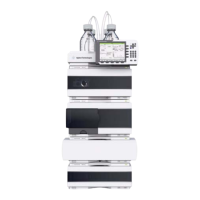1260 Infinity Micro Degasser Service Manual 35
Using the Micro Vacuum Degasser
4
Solvent Information
Material Information
Materials in the flow path are carefully selected based on Agilent’s
experiences in developing highest quality instruments for HPLC analysis
over several decades. These materials exhibit excellent robustness under
typical HPLC conditions. For any special conditions please consult the
material information section or contact Agilent.
Disclaimer
Subsequent data were collected from external resources and are meant as
a reference. Agilent cannot guarantee the correctness and completeness of
such information. Data is based on compatibility libraries, which are not
specific for estimating the long- term life time under specific but highly
variable conditions of UHPLC systems, solvents, solvent mixtures and
samples. Information can also not be generalized due to catalytic effects of
impurities like metal ions, complexing agents, oxygen etc. Apart from pure
chemical corrosion, other effects like electro corrosion, electrostatic
charging (especially for non- conductive organic solvents), swelling of
polymer parts etc. need to be considered. Most data available refers to
room temperature (typically 20 – 25 °C, 68 – 77 °F). If corrosion is
possible, it usually accelerates at higher temperatures. If in doubt, please
consult technical literature on chemical compatibility of materials.
PEEK
PEEK (Polyether- Ether Ketones) combines excellent properties with regard
to chemical resistance, mechanical and thermal stability. It is stable in a
pH range of 1 to 12.5 and inert to many common solvents. There are
several known incompatibilities with chemicals such as chloroform,
methylene chloride, THF, DMSO > 1 %, strong acids (nitric acid > 10 %,
Tabl e 4 Materials in flow path
Part Materials
Internal tubings TFE/PDD copolymer, PFA
Inlets PEEK
Tubi ngs FE P
Fittings ETFE

